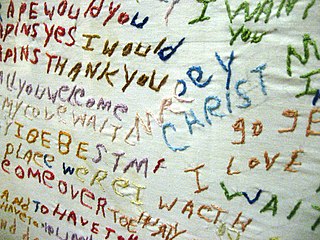Related Research Articles
Psychosis is a condition of the mind that results in difficulties determining what is real and what is not real. Symptoms may include delusions and hallucinations, among other features. Additional symptoms are incoherent speech and behavior that is inappropriate for a given situation. There may also be sleep problems, social withdrawal, lack of motivation, and difficulties carrying out daily activities. Psychosis can have serious adverse outcomes.

Schizophrenia is a mental disorder characterized by continuous or relapsing episodes of psychosis. Major symptoms include hallucinations, delusions, and disorganized thinking. Other symptoms include social withdrawal, and flat affect. Symptoms typically develop gradually, begin during young adulthood, and in many cases never become resolved. There is no objective diagnostic test; diagnosis is based on observed behavior, a psychiatric history that includes the person's reported experiences, and reports of others familiar with the person. To be diagnosed with schizophrenia, the described symptoms need to have been present for at least six months or one month. Many people with schizophrenia have other mental disorders, especially substance use disorders, depressive disorders, anxiety disorders, and obsessive–compulsive disorder.

A thought disorder (TD) is a disturbance in cognition which affects language, thought and communication. Psychiatric and psychological glossaries in 2015 and 2017 identified thought disorders as encompassing poverty of ideas, neologisms, paralogia, word salad, and delusions - all disturbances of thought content and form. Two specific terms have been suggested — content thought disorder (CTD) and formal thought disorder (FTD). CTD has been defined as a thought disturbance characterized by multiple fragmented delusions, and the term thought disorder is often used to refer to an FTD: a disruption of the form of thought. Also known as disorganized thinking, FTD results in disorganized speech and is recognized as a major feature of schizophrenia and other psychoses. Disorganized speech leads to an inference of disorganized thought. Thought disorders include derailment, pressured speech, poverty of speech, tangentiality, verbigeration, and thought blocking. One of the first known cases of thought disorders, or specifically OCD as we know it today, was in 1691. John Moore, who was a bishop, had a speech in front of Queen Mary II, about "religious melancholy."
Kurt Schneider was a German psychiatrist known largely for his writing on the diagnosis and understanding of schizophrenia, as well as personality disorders then known as psychopathic personalities.
In psychology, schizotypy is a theoretical concept that posits a continuum of personality characteristics and experiences, ranging from normal dissociative, imaginative states to extreme states of mind related to psychosis, especially schizophrenia. The continuum of personality proposed in schizotypy is in contrast to a categorical view of psychosis, wherein psychosis is considered a particular state of mind, which the person either has or does not have.
The mental status examination (MSE) is an important part of the clinical assessment process in neurological and psychiatric practice. It is a structured way of observing and describing a patient's psychological functioning at a given point in time, under the domains of appearance, attitude, behavior, mood and affect, speech, thought process, thought content, perception, cognition, insight, and judgment. There are some minor variations in the subdivision of the MSE and the sequence and names of MSE domains.
Disorganized schizophrenia, or hebephrenia, was a subtype of schizophrenia prior to 2013. Subtypes of schizophrenia were no longer recognized as separate conditions in the DSM 5, published in 2013. The disorder is no longer listed in the 11th revision of the International Classification of Diseases (ICD-11).

Thought broadcasting is a type of delusional condition in which the affected person believes that others can hear their inner thoughts, despite a clear lack of evidence. The person may believe that either those nearby can perceive their thoughts or that they are being transmitted via mediums such as television, radio or the internet. Different people can experience thought broadcasting in different ways. Thought broadcasting is most commonly found among people that have a psychotic disorder, specifically schizophrenia.
Paraphrenia is a mental disorder characterized by an organized system of paranoid delusions with or without hallucinations and without deterioration of intellect or personality.

Grandiose delusions (GD), also known as delusions of grandeur or expansive delusions, are a subtype of delusion that occur in patients with a wide range of psychiatric disorders, including two-thirds of patients in a manic state of bipolar disorder, half of those with schizophrenia, patients with the grandiose subtype of delusional disorder, frequently in narcissistic personality disorder, and a substantial portion of those with substance abuse disorders. GDs are characterized by fantastical beliefs that one is famous, omnipotent, wealthy, or otherwise very powerful. The delusions are generally fantastic and typically have a religious, science fictional, or supernatural theme. There is a relative lack of research into GD, in contrast to persecutory delusions and auditory hallucinations. Around 10% of healthy people experience grandiose thoughts at some point in their lives but do not meet full criteria for a diagnosis of GD.
Within the field of clinical trials, rating is the process by which a human evaluator subjectively judges the response of a patient to a medical treatment. The rating can include more than one treatment response. The accessor is normally an independent observer other than the patient, but the accessor can also be the patient. Furthermore, some clinical outcomes can only be assessed by the patient.
The Brief Psychiatric Rating Scale (BPRS) is a rating scale which a clinician or researcher may use to measure psychiatric symptoms such as depression, anxiety, hallucinations and unusual behaviour. The scale is one of the oldest, most widely used scales to measure psychotic symptoms and was first published in 1962.
Childhood schizophrenia is similar in characteristics of schizophrenia that develops at a later age, but has an onset before the age of 13 years, and is more difficult to diagnose. Schizophrenia is characterized by positive symptoms that can include hallucinations, delusions, and disorganized speech; negative symptoms, such as blunted affect and avolition and apathy, and a number of cognitive impairments. Differential diagnosis is problematic since several other neurodevelopmental disorders, including autism spectrum disorder, language disorder, and attention deficit hyperactivity disorder, also have signs and symptoms similar to childhood-onset schizophrenia.
The diagnosis of schizophrenia, a psychotic disorder, is based on criteria in either the American Psychiatric Association's Diagnostic and Statistical Manual of Mental Disorders, or the World Health Organization's International Classification of Diseases (ICD). Clinical assessment of schizophrenia is carried out by a mental health professional based on observed behavior, reported experiences, and reports of others familiar with the person. Diagnosis is usually made by a psychiatrist. Associated symptoms occur along a continuum in the population and must reach a certain severity and level of impairment before a diagnosis is made. Schizophrenia has a prevalence rate of 0.3-0.7% in the United States
A religious delusion is defined as a delusion, or fixed belief not amenable to change in light of conflicting evidence, involving religious themes or subject matter. Religious faith, meanwhile, is defined as a belief in God or a religious doctrine in the absence of evidence. Psychologists, scientists, and philosophers have debated the distinction between the two, which is subjective and cultural.
The relationship between religion and schizophrenia is of particular interest to psychiatrists because of the similarities between religious experiences and psychotic episodes; religious experiences often involve auditory and/or visual phenomena, and those with schizophrenia commonly report hallucinations and delusions that may resemble the events found within a religious experience. In general, religion has been found to have "both a protective and a risk increasing effect" for schizophrenia.
The Scale for the Assessment of Negative Symptoms (SANS) is a rating scale that mental health professionals use to measure negative symptoms in schizophrenia. Negative symptoms are those conspicuous by their absence—lack of concern for one's appearance, and lack of language and communication skills, for example. Nancy Andreasen developed the scale and first published it in 1984. SANS splits assessment into five domains. Within each domain it rates separate symptoms from 0 (absent) to 5 (severe). The scale is closely linked to the Scale for the Assessment of Positive Symptoms (SAPS), which was published a few years later. These tools are available for clinicians and for research.
Within psychological testing, the Scale for the Assessment of Positive Symptoms (SAPS) is a rating scale to measure positive symptoms in schizophrenia. The scale was developed by Nancy Andreasen and was first published in 1984. SAPS is split into 4 domains, and within each domain separate symptoms are rated from 0 (absent) to 5 (severe). The scale is closely linked to the Scale for the Assessment of Negative Symptoms (SANS) which was published a few years earlier.

Tactile hallucination is the false perception of tactile sensory input that creates a hallucinatory sensation of physical contact with an imaginary object. It is caused by the faulty integration of the tactile sensory neural signals generated in the spinal cord and the thalamus and sent to the primary somatosensory cortex (SI) and secondary somatosensory cortex (SII). Tactile hallucinations are recurrent symptoms of neurological diseases such as schizophrenia, Parkinson's disease, Ekbom's syndrome and delerium tremens. Patients who experience phantom limb pains also experience a type of tactile hallucination. Tactile hallucinations are also caused by drugs such as cocaine and alcohol.
References
- ↑ Liechti, Stacy; Capodilupo, Gianna; Opler, Douglas J.; Opler, Mark; Yang, Lawrence H. (2017-12-01). "A Developmental History of the Positive and Negative Syndrome Scale (PANSS)". Innovations in Clinical Neuroscience. 14 (11–12): 12–17. ISSN 2158-8333. PMC 5788246 . PMID 29410932.
- ↑ Opler, Mark G.A.; Yavorsky, Christian; Daniel, David G. (2017-12-01). "Positive and Negative Syndrome Scale (PANSS) Training". Innovations in Clinical Neuroscience. 14 (11–12): 77–81. ISSN 2158-8333. PMC 5788255 . PMID 29410941.
- ↑ "Mental Health and Schizophrenia". WebMD. Retrieved 2019-07-29.
- 1 2 Kay SR, Fiszbein A, Opler LA (1987). "The positive and negative syndrome scale (PANSS) for schizophrenia". Schizophr Bull. 13 (2): 261–76. doi: 10.1093/schbul/13.2.261 . PMID 3616518.
- ↑ John Hunsley; Eric J. Mash (2008), A Guide to Assessments that Work, Oxford University Press US, ISBN 978-0-19-531064-1
- ↑ Kay, Stanley R. (1991), Positive and Negative Syndromes in Schizophrenia, Routledge Mental Health, pp. 33–36, ISBN 978-0-87630-608-6
- ↑ Vandergaag, M.; Hoffman, T.; Remijsen, M.; Hijman, R.; Dehaan, L.; Vanmeijel, B.; Vanharten, P.; Valmaggia, L.; Dehert, M.; Cuijpers, A.; Wiersma, D. (2006-07-01). "The five-factor model of the Positive and Negative Syndrome Scale II: A ten-fold cross-validation of a revised model". Schizophrenia Research. 85 (1–3): 280–287. doi:10.1016/j.schres.2006.03.021. ISSN 0920-9964. PMID 16730429. S2CID 9097109.